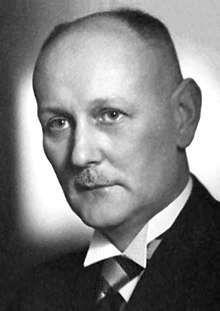Gerhard Domagk
Gerhard Johannes Paul Domagk (30 October 1895 – 24 April 1964) was a German pathologist and bacteriologist. He is credited with the discovery of Sulfonamidochrysoidine (KI-730), the first commercially available antibiotic and marketed under the brand name Prontosil, for which he received the 1939 Nobel Prize in Physiology or Medicine.[3][4][5][6][7]
Gerhard Domagk | |
|---|---|
 | |
| Born | Gerhard Johannes Paul Domagk 30 October 1895 |
| Died | 24 April 1964 (aged 68) Burgberg |
| Nationality | German |
| Alma mater | University of Kiel |
| Known for | Development of sulfonamides [1] such as Prontosil |
| Spouse(s) | Gertrud Strube |
| Children | One daughter and three sons |
| Awards | Cameron Prize for Therapeutics of the University of Edinburgh (1939) Nobel Prize in Medicine (1939) Fellow of the Royal Society (1959)[2] |
| Scientific career | |
| Fields | Bacteriology |
Education
Domagk was born in Lagow, Brandenburg, the son of a school headmaster. Until he was 14, he attended school in Sommerfeld (now Lubsko, Poland). Domagk studied medicine at the University of Kiel, but volunteered to serve as a soldier in World War I, where he was wounded in December 1914, working the rest of the war as a medic. After the war, he finished his studies, and worked at the University of Greifswald, where he researched infections caused by bacteria.
Career
In 1925, he followed his professor Walter Gross to the University of Münster (WWU) and became a professor there himself. He also started working at the Bayer laboratories at Wuppertal. The same year, he married Gertrud Strube (1897–1985). Later they would have three sons and a daughter.
Domagk was appointed director of Bayer's Institute of Pathology and Bacteriology, where he continued the studies of Josef Klarer and Fritz Mietzsch, based on works by Paul Ehrlich, to use dyes, at that time a major product of IG Farben, as antibiotics. He found the sulfonamide Prontosil to be effective against streptococcus, and treated his own daughter with it, saving her the amputation of an arm.
In 1939, Domagk received the Nobel Prize in Medicine for this discovery, the first drug effective against bacterial infections. He was forced by the Nazi regime to refuse the prize and was arrested by the Gestapo and detained for a week.[8][9][10] (This was because the Nazi-critical Carl von Ossietzky had won the Nobel Peace Prize in 1935, which had angered the German government and resulted in German nationals not being permitted by law to accept the Nobel Prize.[10]) In the same year, Domagk was also awarded the Cameron Prize for Therapeutics of the University of Edinburgh. In 1941 Domagk was awarded the Medaglia Paterno (Rome) by the Kingdom of Italy and also the Von-Klebelsberg-Medal and Prize by the Kingdom of Hungary. He became a member of the German Academy of Sciences Leopoldina in 1942. Sulfonamides had revolutionary antibacterial effectiveness for their time, surpassing phage therapy, but were later replaced by penicillin, which showed both better effects and fewer side effects (sulfonamides can cause kidney stones and changes in bone marrow). However, Domagk's work on sulfonamides eventually led to the development of the antituberculosis drugs thiosemicarbazone and isoniazid, which helped to curb the epidemic of tuberculosis which swept Europe after World War II.
After the war, in 1947, Domagk was finally able to receive his Nobel Prize,[11] but not the monetary portion of the prize due to the time that had elapsed. In 1951, he was one of seven Nobel Laureates who attended the 1st Lindau Nobel Laureate Meeting.[12]
Domagk became a Foreign Member of the Royal Society in 1959; his short biography was published by the Royal Society in 1964.[2][10] He changed his focus to tuberculosis and chemotherapy against cancer. He continued to live and work in Wuppertal. Domagk died from a heart attack in Burgberg near Königsfeld, Schwarzwald.
References
- Otten, H. (1986). "Domagk and the development of the sulphonamides". The Journal of Antimicrobial Chemotherapy. 17 (6): 689–696. doi:10.1093/jac/17.6.689. PMID 3525495.
- Colebrook, Leonard (1964). "Gerhard Domagk 1895-1964". Biographical Memoirs of Fellows of the Royal Society. 10: 38–50. doi:10.1098/rsbm.1964.0003.
- Gerhard Domagk on Nobelprize.org
- "The Nobel Prize in Physiology or Medicine 1939 Gerhard Domagk". Nobelprize.org. Retrieved 2 July 2010.
- Raju, T. N. (1999). "The Nobel chronicles. 1939: Gerhard Domagk (1895–1964)". Lancet. 353 (9153): 681. doi:10.1016/S0140-6736(05)75485-4. PMID 10030374.
- Kyle, R. A.; Shampo, M. A. (1982). "Gerhard Domagk". JAMA: The Journal of the American Medical Association. 247 (18): 2581. doi:10.1001/jama.247.18.2581. PMID 7040718.
- "G. Domagk". British Medical Journal. 1 (5391): 1189–1191. 1964. doi:10.1136/bmj.1.5391.1189. PMC 1813461. PMID 14120818.
- Thomas Hager, The Demon Under the Microscope (2006) ISBN 1-4000-8213-7 (cited in "The Saga of a Sulfa Drug Pioneer" – NPR Weekend Edition 23 December 2006)
- NobelPrize.org Archived 2 February 2007 at the Wayback Machine
- Schück, Henrik; Ragnar Sohlman; Anders Österling; Göran Liljestrand; Arne Westgren; Manne Siegbahn; August Schou; Nils K. Ståhle (1950). "The Prize in Physiology and Medicine: The Nobel Prizes in Wartime". In Nobel Foundation (ed.). Nobel: The Man and His Prizes. Stockholm: Klara Civiltryckeri. pp. 167–179.
- Chorba, Terence (March 2018). "Peace, Liberty, Mycobacteria, and Tuberculosis Mortality". Emerg Infect Dis. 24 (3): 611–612. doi:10.3201/eid2403.AC2403. PMC 5823360.
- "1st Lindau Nobel Laureate Meeting - Laureates". www.mediatheque.lindau-nobel.org. Retrieved 9 January 2018.
External links
- Gerhard Domagk on Nobelprize.org including the Nobel Lecture on 12 December 1947 Further Progress in Chemotherapy of Bacterial Infections
